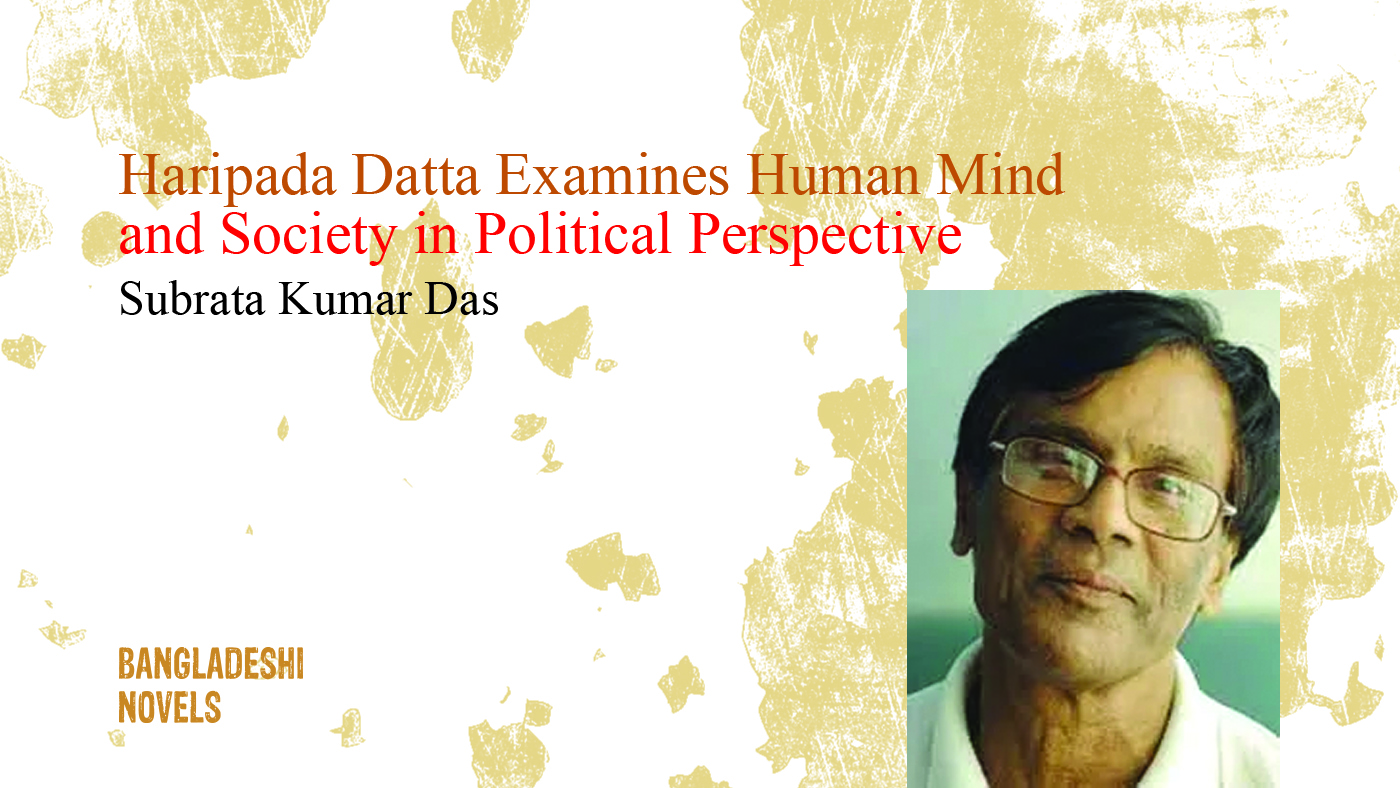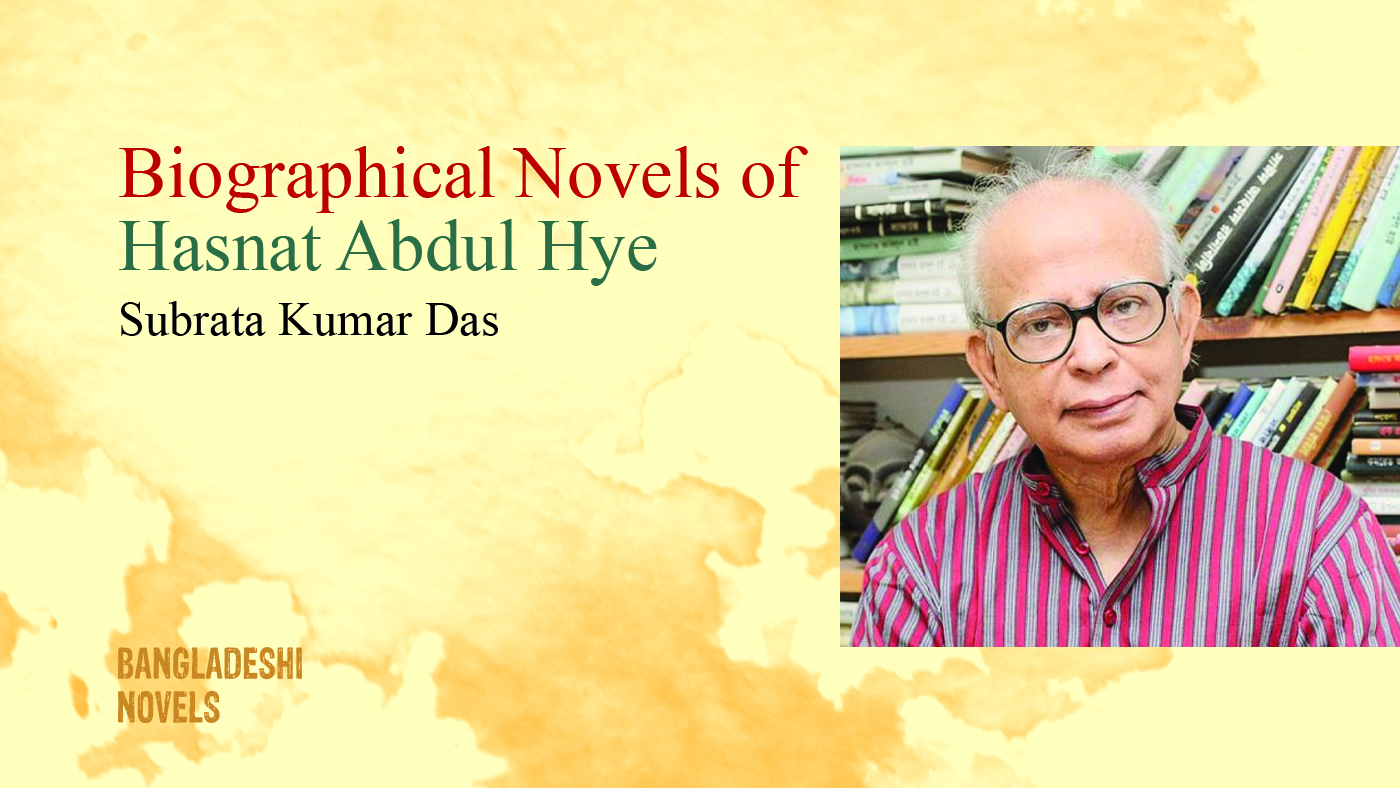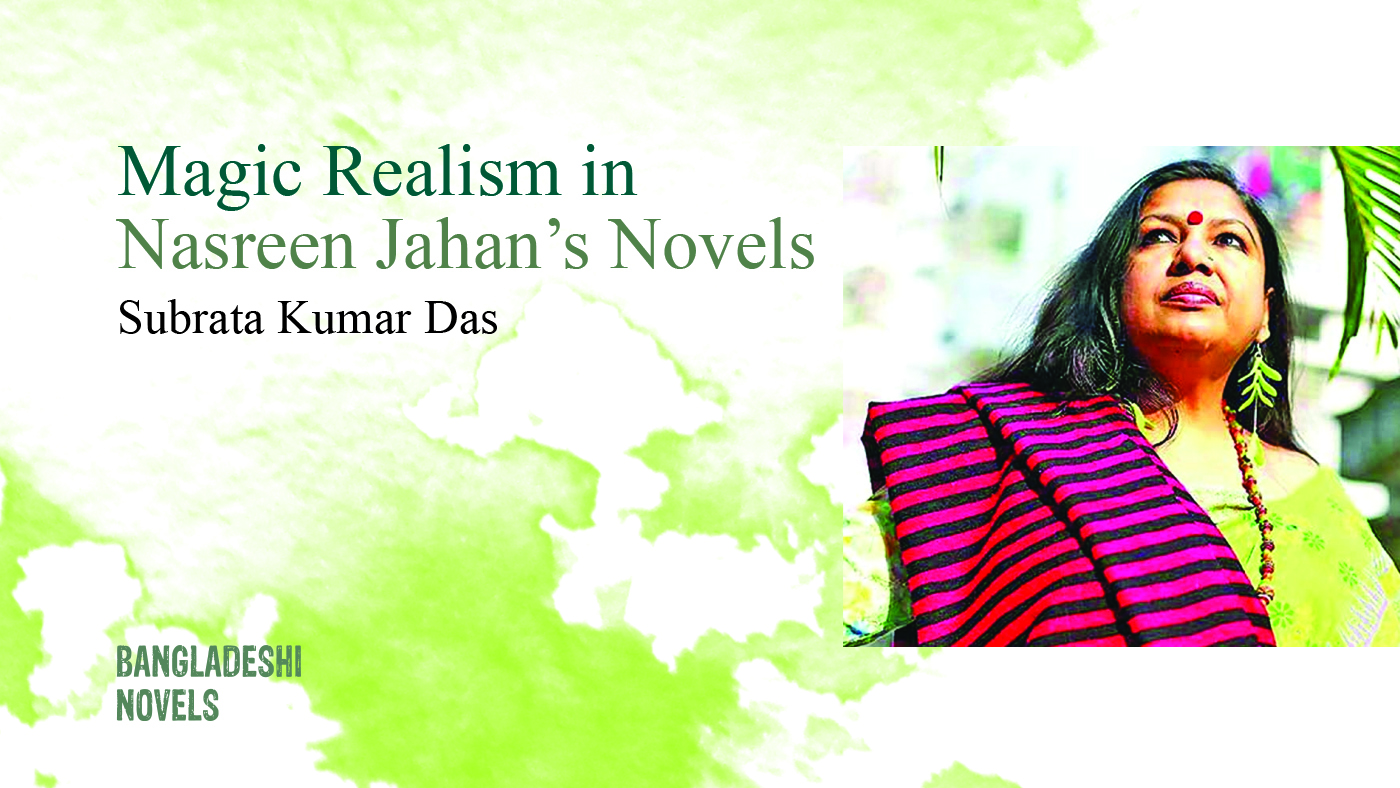
Al Mahmud (1936-2019) is one of the major poets in Bangladesh. His got his recognition immediately after the publication of his volume of verse Lok Lokantor (1963). Later on Kaler Kalosh (1966), Sonali Kabin (1966), Mayabi Porda Dule Otho (1969) established his position in the row of pioneer and prominent poets of the country. After the liberation war of 1971, he began to practise fiction along with poetry. The year 1975 brought his first book of short stories titled Pankourir Rokto, which created a tumultuous reaction among the Bangla literature readership. The other volumes of his short stories are Souraver Kachhe Porajito (1983), Gandho Bonik (1988), Moyurir Mukh (1994) etc. In the meantime he has set in the world of novels also. Dahuki (Gallinule, 1992), the first novel from Al Mahmud’s pen, could not prove as a great success but showed the possibility what he could do. A brighter light of it was observed when Kobi O Kolahol (The Poet and the Chaos) got published in 1993. The publication of Upamohadesh (The Subcontinent) and Kabiler Bone (Kabil’s Sister) in the same year declared the genius of his in this arena. The later efforts that were proved successful are Purush Sundor, (Man and Beauty, published in 1994) and Nishinda Nari (A Herbal Woman), Moru Mushiker Upatyaka (A Valley of the Desert Rats), Aguner Meye (A Jinn Girl, all published in 1994) etc. The most noteworthy feature in Al Mahmud’s novels is that his pen always dares to reveal the life that has barely been sketched in others’ fictional works.
In reality Al Mahmud started his novelistic career with his autobiographical book Je Bhabe Bere Uthi (1984). Though this book is not commonly considered as a novel, it bears some characteristics available in a novel. The next book Dahuki brought Al Mahmud the recognition of a novel writer and he himself admits that it created the self-reliance in him. Ateka Banu, a professor of English of Dhaka University is the protagonist in this novel. The memories of adolescent Ateka are intermingled juxtapositionally with the present Ateka of thirty-eight. The other characters of the novel are Professor Shahed – Ateka’s husband, Keramot – a boy who served in the farmland of Ateka’s father and became Ateka’s friend and lover, Sufia – Keramot’s wife and Firoza – a professor of psychology whom Shahed wants to marry now etc. The two episodes that are moulded in the main story line of the novel are of Ateka – Keromot relationship and Professor Shahed’s boyhood days in a prostitution area.
The novel opens with Ateka Banu who is on a visit to her village home Ramrail in the district of Bahmanbaria. On her holidays of the Eid-ul-Ajhah she pays this visit with a view to getting peace. If we look into her conjugal life we will observe the lack of only one thing that is peace. Ateka and her husband began to sleep in different beds due to a very silly matter, and that practice has been lasting till date. In the meanwhile another woman, Feroza, came closer to Professor Shahed. During Ateka’s visit to the village home she meets her classical teacher of childhood days who creates a mysterious influence on her. Resultantly she returns to Dhaka and after an open talk with her husband they two come to a mutual decision.
The other episode of the novel is with Ateka’s girlhood love Keramot Ateka got separated from her lover since she left village for schooling but she kindles her love till date. Now she has given all the responsibilities of her farmland to Keramot for which her cousins of the village home do not like Keramot. They spread different rumours about their relation though Ateka do not care much for those. Alongside the thing that is worthy to mention is that Keramot’s wife Sufia hears all these rumours. She believes her husband but she cannot rely him completely for which on the night Keramot goes to meet Ateka, Sufia follows him alone in that night though not barehanded, but with a Ramda (a sword like weapon) in her hand. While narrating the stories, the author inserts the girlhood memories of Ateka with Keramot or with Kamrun, Ateka’s girlhood friend.
On the other hand, Shahed was brought up nearby prostitution, where Poribanu, a sex worker of the brothel, extended her helping hand to Shahed and his father. After the death of Shahed’s father, Poribanu provided the necessary financial help for which Shahed has been able to continue his studies. But the harsh reality is Shahed denied all his past bindings and the truth is his denial helped him to attain the present position. Yes the past memories haunt him though he cannot ventilate it to his wife. During Ateka’s visit to village when he goes to the prostitute we can feel the nostalgia that he nourishes.
It is true that there are some episodes in the novel that we cannot tolerate – these episodes are related with the early days of Ateka and Keramot. The dialogue which came forth of Kamrun’s mouth regarding Ateka–Keramot relationship seem quite unnatural – because even in agrarian village society people of tender age do not speak so much slang before people of opposite sex. Some other approaches like Keramot’s desire to see the breasts of Ateka or show the mating of an ox with a cow also go beyond the natural norm of behaviour.
The next novel of Al Mahmud that we are going to examine is Kabiler Bone. By now another novel of him having human love at its centre, has been published under the title Kobi O Kolahal. Along with that he has also published Upamahadesh written on the theme of liberation war. Upamahadesh spans the whole liberation war on a direct and broad scale; on the other hand Kabiler Bone focuses mostly on the dilemma of the Biharies staying in East Pakistan. The novel ends with the end of the liberation war and its illumination on a newer aspect draws many to its uniqueness.
The story of the novel opens in 1960 when Kabil, a boy of sixteen or seventeen, reaches Dhaka town from a interior village of the district Sylhet. Completing his matriculation examinations he has started for Dhaka to get admitted into a college. In Dhaka he has to become a guest at his uncle Ahmed Alam’s house whom Kabil’s father disowned for his marrying a Bihari woman. Kabil’s auntie welcomes him warmheartedly in her house and her daughter Roksana, in fact, falls in love with Kabil at first sight. Later on, the gradual development of the love affair of Kabil and Roksana is a major theme of the novel, but surpassing all these the thing that becomes penetrating is the controversial relationship between the Bangali and the non-Bangali people. Al Mahmud has drawn the picture of the tragedy of the minority in a very heart felt presentation.
The love relationship between the four people in Kabiler Bone is really complex. These four persons are: Kabil, his two cousins: Momena and Roksana; Roksana’s cousin non-Bangali Andalib Immediately after the arrival of Kabil at Dhaka, Roksana gets fascinated to him though she was earlier interested in Andalib who looks after Roksana’s mother’s business. On the other hand before Kabil’s returning to his village home with Roksana, Jakia Banu, mother of Kabil, was bringing up her brother’s orphan daughter Momena in her own house with a view to preparing Momena for Kabil. Much after when Andalib pays a visit to Kabil’s house, he gets fascinated to Momena which later on turns to the final of marriage. But the fact is Momena has a deep love for Kabil, which was apparently a sort of performing familial duties by Kabil. At the end of the novel we discover that Roksana has left for West Pakistan with Andalib on the pretext that he has no other relative than she. After the liberation war when the question of marriage between Kabil and Momena arises, the latter denies it because she is not inclined to take Kabil as an alms from Roksana, though Momena herself once tolds Andalib if she is to choose one between Kabil and Andalib, her preference will be the first one. Last of all Kabil marries Anjuman, his friend Nisar’s wife whose husband was shot dead on 25 March at the university hall gates by the Pakistan army personnel. Al Mahmud has delineated the different facets of the complex relationship of human love very skillfully. The novelist thus illuminates the unknown core of an individual’s mind.
But we must agree that Kabiler Bone is much more noteworthy for its Bangali-NonBangali question. In the very first part of the five-part novel this dilemma takes an introduction. For his marrying a Mohajir woman Kabil’s uncle is not welcomed in the Bangali society even after being a big businessman. Zakia Banu’s speech proves that it did not have any root in the personal view but it was a socio-political aspect. Zakia Banu says, ‘Are the Bihari people not alike us? Don’t they have anything like love?’ But the conflict gets exposed as a social phenomenon in the seventh chapter of part-I on the day Kabil and Roksana return from Montala. In the same train the National Leader of the Bangalis Shorawardy accompanied by Sheikh Mujib, arrive. On that day some Bangali hooligans create a hue and cry at the station and damage the property and shops of the non-Bangalis.
Sheikh Mujibur Rahman is a prominent character in this novel, though his presence is always passive. Al Mahmud has tried to portray the powerful personality of this great leader with necessary importance. His directions to and conversations with Kabil act as a great treasure in the novel.
Part II of the novel begins with the politics of the 1969, the most tumultuous time in the history of our nation. In that politics Kabil and Roksana are mostly involved. Kabil appears a bit more advanced – he is the Assistant Secretary of the Dhaka University Students’ Union. The novelist has tried to draw the picture of this time through his plot and characters in Kabiler Bone. Later on the police arrests Kabil and gradually he comes nearer to Sheikh Mujib Though some of his fellow leaders try to present him as a conspirator with the Bihari people, but they do not succeed because Sheikh Mujib never identifies a person wrongly. As a result Kabil is awarded with the foremost leadership of the students’ wing. At the end of part II we see Kabil’s mother dies, his uncle follows her failing to bear the great shock of her death, and Kabil is again handicapped during his return from the graveyard.
Part III illustrates the final days of the pre-liberation era where Sheikh Mujibur Rahman is the highest leader and the students’ part is led by Kabil. One day while Kabil is leaving home for Sheikh Mujib’s Rawnak tells her something and requests Kabil to convey that message to Sheikh Mujib Her anxiety for the security of the non-Bangalis has been demonstrated in her speech. The more the final of liberation approaches the more the insecurity of the non-Bangalis increases. Roksana is the greatest victim of this situation. Who will she support – her non-Bangali mother, or her Bangali beloved brother? Right before March 25, the problem becomes more and more crucial – the Mojahirs begin to crowd in Mirpur and Mohammadpur areas. Even Andalib has to leave his residential area Narida. Though Kabil makes some arrangements against it that does not last long. The fear in Rawnak Zahan also reached the peak: ‘My daughter’s Bangali, but I’m Mohajir. I’ve no motherland. I’ve none of my own. The residents of the nearby locality want to oust me’. Thanks God she does not have to see every thing in her own eyes – on the night of 25 March her heart fails. The other two sufferers Roksana and Andalib leave Bangladesh for Pakistan. Thus Kabiler Bone becomes a true document of humanity which becomes most prominent in the words of Roksana: ‘Observing the cruelties of human being, I’ve learnt that my only identity in life is my birth as a human being’.
The next novel of Al Mahmud is Nishinda Nari. Though it is very thin in volume, it possesses many qualities worthy to be talked about. Full of images this novel has been ornamented with a huge number of symbols that have given it a good height. According to some critics, this is the most significant novel of Al Mahmud.
The story of the novel is set in a village of Brahmanbaria by the river Titas. Nishinda, the protagonist of the novel, appears in the very first line of the novel and in the very first chapter the two main components of human history – sex and hunger – appear in their full appearance. In the same chapter Nishinda also gets the means of gratification of these two desires in her dream in which supernatural situation the cows appear. In her dream the conversation between the cows and Nashinda gives tongue to the subconscious thought of this anormal, hungry woman. Every detail of her casts a sort of spell on the reader. In a very brief span of time we get many more information about her that strike the reader and all these characteristics help the writer create her as a woman beyond the usual trend.
In the dream one of the cows catches hold the corner of Nishinda’s Sari for which her chest opens bear. When the dream ends again we get the hints of her bare chest. Thus the sex elements are intermingled in the main story line which turn beautiful due to the poetic touch of Al Mahmud’s pen. Awaking up from her sleep, Nishinda feels her hungers and decides to go to the nearby pasture where the herdsmen will miltch the cows and send the milk to the bazaars at dawn. She does not forget that if her arrival become exposed to the herdsmen, they will not hesitate to violate her gangbang. So she takes the ramda with her for her safety. Later on when Nishinda is caught hold of by a herdsman he does not fear her Ramda, rather he praises the bust of her and thus the beauty takes the upper hand over every other thing else.
But Nishinda Nari does not meet an end here. It takes a larger horizon for its story line. The next morning, we learn that Abdullh Majhi has been killed and the news of his death comes through the policemen. When Nishinda tells that she suspects everyone for the death of her husband a new facet opens before the readers’ eyes. Next night comes Khalil, a fellow comrade of Abdullah – in guise of a well wisher he actually wants to grab the arms of Abdullah. He even offers Nishinda cash money for them but her final word is: ‘Before knowing the killer of Abdullah, I won’t give them to anyone’. At a moment when Abdullah takes out his pistol, he loses one of his fingers to the ramda of Nishinda.
The other person who also loses his finger is the manager of the brickfield. On advice of the police officer when Nishinda agrees to leave the household to the manager, accordingly he comes but not with the decided money. Thus the conflict arises and when the manager tries to impose power on her, she rather snatches the money. In this game of attack and counter attack, the manager loses his finger being hit by the ramda. Cleansing the weapon when she retires to bed, the cows of her dream begin to shout: ‘Abdullah hasn’t died. He’s been killed but he’s not dead. Abdullah will remain alive among us forever’. Being waked up she sees all the people of the locality crowding in her courtyard – they have gathered there to save Nishinda with the little they have. The similar human treatment Nishinda receives from the herdsman of the pasture also. On the second night as she goes to sacrifice herself to that herdsman for his kindness on the first day, he denies to receive her because instantly he understands the deep hunger of Nishinda. Thus the novel becomes an artistic piece of humanity and beauty.
In regard to Al Mahmud’s next novel Aguner Meye, it may be commented that the height that Nishinda Nari got is not available in the next one. The narrator of the novel Aguner Meye is the Rezaul Karim, a journalist. Excluding Rezaul along with Rezaul’s finance Kausari Begum and the house owner, there is another very prominent character in the novel – Jahanur N’r, a Jinn. Getting up into the newly rented house, Rezaul meets this imaginary character on the first night. The writer has delineated the physical and psychological features of the Jinn also. Maybe some of the critics appreciate it for its alien subject, but finally this novel cannot take the readers to an uplifted feeling.
We may observe that though Al Mahmud started writing up novels in the nineties of the twentieth century, more than two decades after his poetic endevours, he has invented a world of his own. Innovation of new subjects for his novels is very worthy to notice. From the point of lofty idea, Kabiler Bone is appreciated highly by some of the critics, but on the other hand some other critics appreciate Nishinda Nari most. No doubt he has been able to create a permanent place in the contemporary fiction from Bangladesh.







